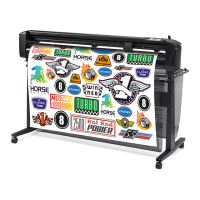Set the cutting speed
The speed at which the tool moves is determined by four dierent parameters: speed and acceleration while the
tool is down; speed and acceleration while the tool is up. These four parameters have been represented by just
one parameter so that you can change the speed quickly and easily.
This parameter is called velocity; it is the speed of the cutter when the tool is down. If the velocity is raised or
lowered, the other parameters are also raised or lowered accordingly.
NOTE: The speed at which the cutter pulls the substrate from the roll is xed at 200 mm/s (8 in/s).
Set the velocity
1. Turn on the cutter.
2.
Press .
3.
Press . System setup appears on the screen. Press .
4.
Press to Settings, then press .
5.
Press to change the velocity, then press to conrm. An asterisk appears by the velocity,
indicating that it is now the selected value.
6.
Press twice to leave the menu.
Set the speed parameters separately
1. Turn on the cutter.
2.
Press .
3.
Press . System setup appears on the screen. Press .
4.
Press or to scroll through the menu until you reach Settings.
NOTE: Velocity is the main speed parameter. The default value for the three other parameters is AUTO. This
means that they are linked to velocity (which is the speed when the tool is down). The AUTO parameters can be
set individually, but will then cease to be linked to the velocity parameter.
Perform length calibration
The cutter has been calibrated in the factory for standard 2-mil cast or 3-mil calendared vinyl. A dierent
calibration factor can be associated with each of the four users. This is particularly helpful for multi-colored
signs: it ensures that the parts in dierent colors match up, even if dierent types of vinyl are used.
For standard use, it is not necessary to calibrate the cutter. With standard vinyl, the accuracy is within 0.2%.
However, if high accuracy between dierent vinyls or colors is needed, then calibration is necessary.
1. Turn on the cutter, load substrate, and mount the knife.
NOTE: The wider and longer the substrate, the more accurate the calibration will be. Use a piece of vinyl
of maximum width and a length that is approximately 1.5 times the width.
2.
Press .
20 Chapter 3 Load the substrate ENWW

